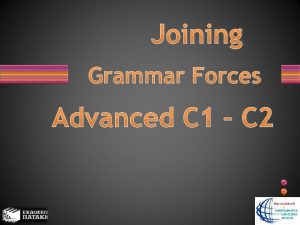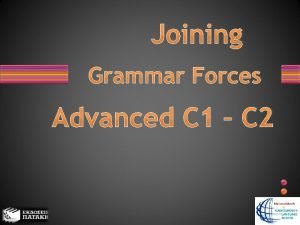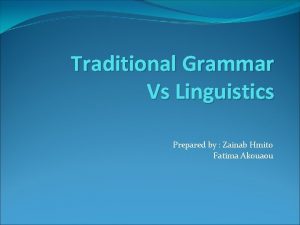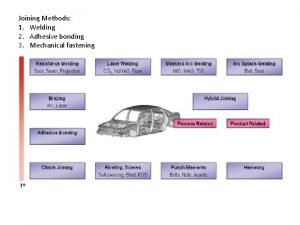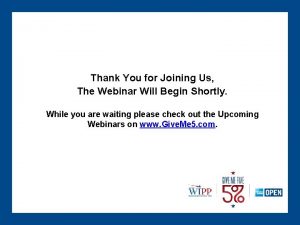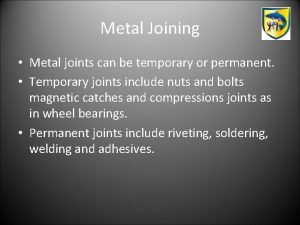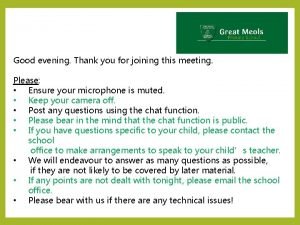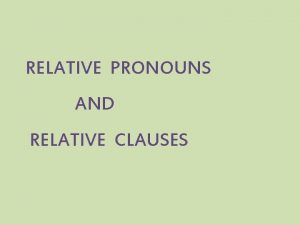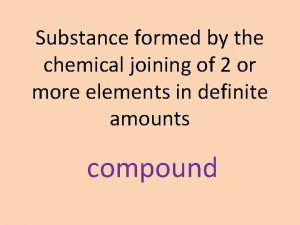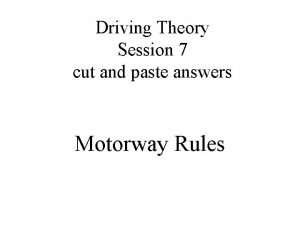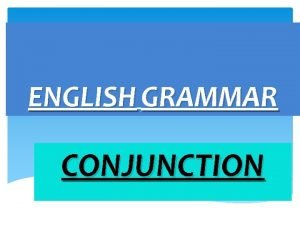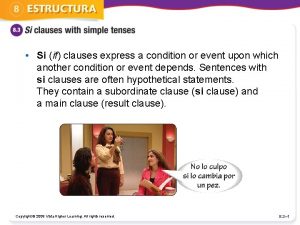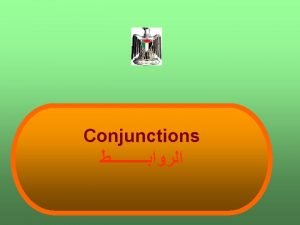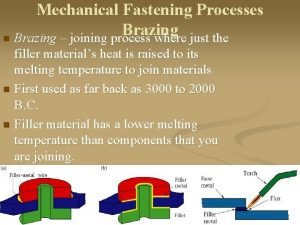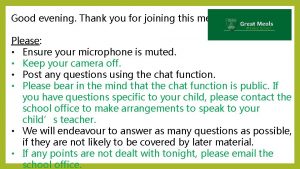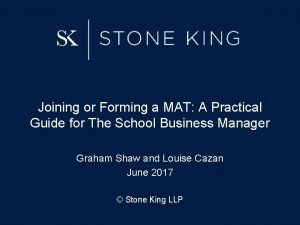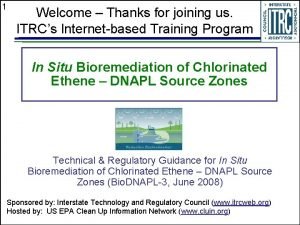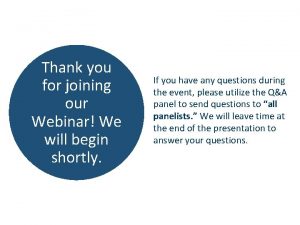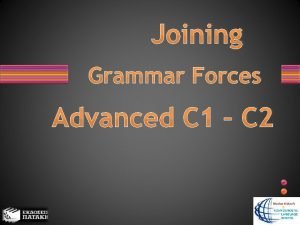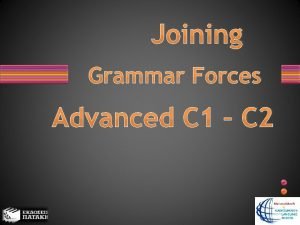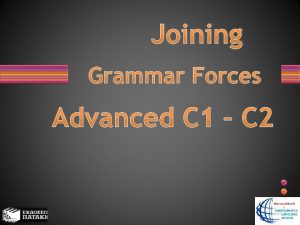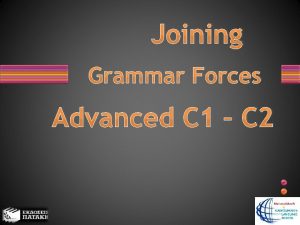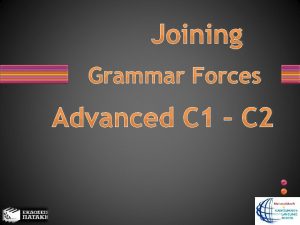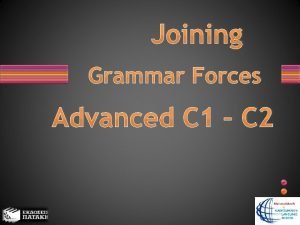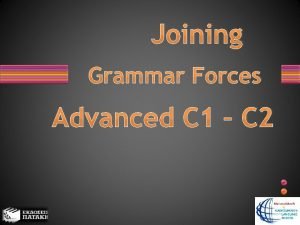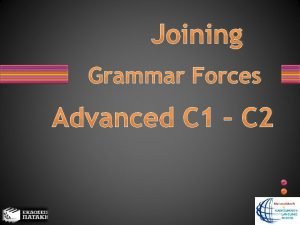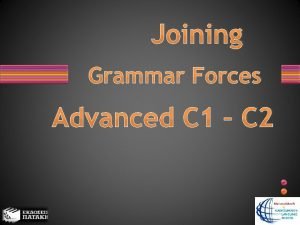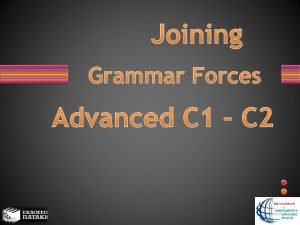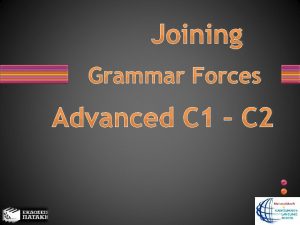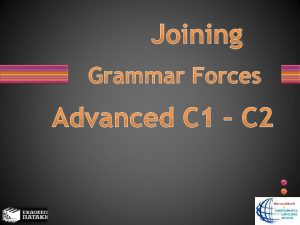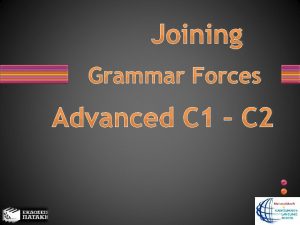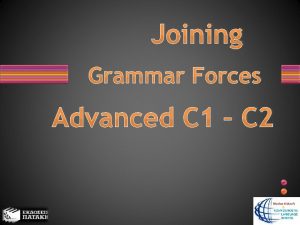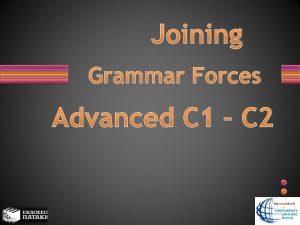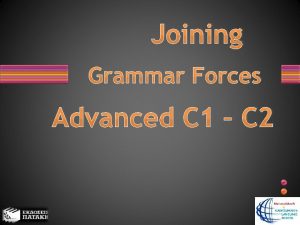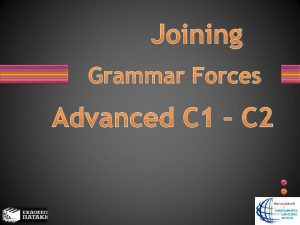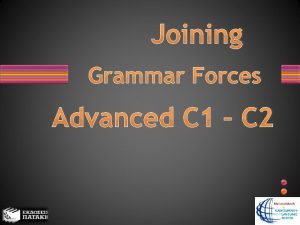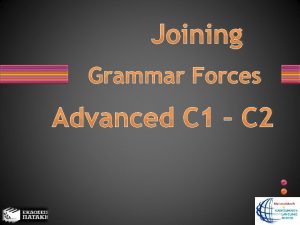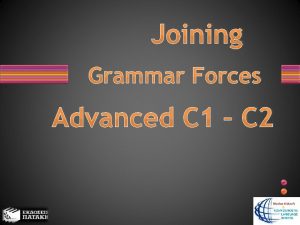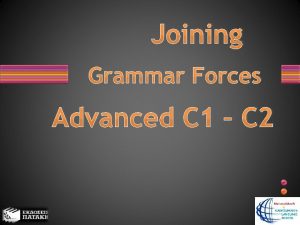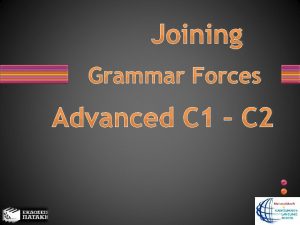Joining Grammar Forces Advanced C 1 C 2
















































- Slides: 48

Joining Grammar Forces Advanced C 1 – C 2

Unit 8 – Presentation 1 • How many forms does the English verb have? 3: the infinitive, the gerund & the participle • What is their main use? To shorten speech & link sentences (among others)

The Infinitive Presentation 2

What is the ‘infinitive’? The base form of the verb without a personal pronoun-subject before it. And what is it divided into? Full Infinitive (with ‘to’) Bare Infinitive (without ‘to’)

Bare Infinitive Uses a) After the Modal Verbs (except for ought) b) After: had better, would rather/ sooner c) After the verbs make, let IN THE ACTIVE VOICE d) After the verbs see, hear, feel, watch, notice, observe, look at, listen to IN THE ACTIVE VOICE for an action that we perceived in its entirety e) After ‘why’ (not)

Bare Infinitive Uses (cont’d) f) After and that links 2 infinitives g) After the auxiliary or main verbs do/ does/ did h) After the verb have in the structure: have sb do sth i)After the verb help (to infinitive is also possible) j) After but (meaning except), in negative statements.

Full Infinitive Uses a) After adjectives expressing emotion (in same person constructions) b) After nouns c) To express Purpose d) In too & enough constructions e) After certain verbs, like:

Verbs followed by a ‘to-infinitive’ agree arrange care decide fail want wish need urge beg claim pretend seem appear attempt tend seek cause dare hope manage enable empower promise tell encourage trust force compel expect choose hesitate ask demand instruct turn out oblige order prepare refuse require either immediately or in the structure: sb + to-infinitive

Full Infinitive Uses (cont’d) f) In impersonal constructions, starting with It g) After the Indefinite Pronouns & adjectives like: the first, the last, the only (one), in place of a relative clause h) After Question Words (exc. why), in place of a subordinate clause i) To show Negative Result (usu. after only) j) After be (omitting should).

Infinitive Time Forms These are unchanged forms that show the infinitive relates to the main verb time-wise. They are:

Infinitive Time Forms – Uses NAME ACTIVE Simple (to) work Continuous (to) be working PASSIVE (to) be worked ---- These forms refer to a time point that is either the same as or later than that of the main verb Perfect (to) have worked Perfect Continuous (to) have been working (to) have been worked ---- These forms refer to a time point that is earlier than that of the main verb OR replace the Future Perfect Forms

Change of Person for the Infinitive • If the subject of the infinitive is the same as that of the main verb (same-person construction), it is not repeated. e. g. I want to go home. • If it is different, then: a) it is markedly mentioned b) it comes before the infinitive c) it is in the accusative case e. g. I want Jim to go home/ I want him to go home

Change of Person – Infinitive (cont’d) • If the subject of the infinitive (Jim/ him) is the object of the main verb (want), it is already in the accusative. When it is not, we turn it with the preposition for, using the rule: accusative after a preposition, i. e. e. g. I held the door wide open for granny to come in. • Here, the object of the main verb (held) is ‘the door’ and therefore ‘granny’, which is the subject of the infinitive, has nothing to do with it, so we need for to make it into an accusative noun.

The Gerund Presentation 3

How is the ‘gerund’ formed? The Bare Infinitive + -ing And what is it grammatically? A verb-noun

Gerund Uses a) After prepositions b) As (part of) a Subject c) As (part of) an Object i) after certain verbs: ii) after certain expressions: iii) after certain expressions with the preposition ‘to’:

Verbs followed by a ‘gerund’ (i) admit avoid appreciate anticipate carry on consider delay deny dislike despise detest discuss enjoy entail escape envisage excuse finish fancy foresee forgive up hate imagine involve justify keep (on) love like loathe lose miss mind mention necessitate postpone put sth off quit risk recall recollect report resent resist save suggest set/ start sb spend stop sb tolerate understand waste

Expressions followed by ‘gerund’ (ii) be busy can’t stand can’t bear can’t help it’s no use/ good how/ what about it’s (not) worth what’s the use of what’s the point of there’s no point in/ it’s pointless feel like it’s a waste of there is no have difficulty/ trouble/ a hard time

Expressions with ‘to’ followed by ‘gerund’ (iii) be used/ accustomed to get used/ become accustomed to objection to look forward to in addition to prefer … to. . .

Gerund Time Forms These are more or less the same as those of the infinitive, i. e. unchanged forms that show the gerund relates to the main verb time-wise. They are:

Gerund Time Forms – Uses NAME Simple ACTIVE searching PASSIVE being searched These forms (mainly) refer to a time point that is either the same as or later than that of the main verb Perfect having searched having been searched These forms refer to a time point that is earlier than that of the main verb NB. The perfect forms are rarely used, if ever, because they are too formal & the order of actions is often obvious even with the simple forms.

Change of Person for the Gerund • If the subject of the gerund is the same as that of the main verb (same-person construction), it is not repeated. e. g. I enjoy walking in the rain. • If it is different, then: a) it is markedly mentioned b) it comes before the gerund c) it is in the possessive (Jim’s/ his) OR the accusative case (Jim/ him) e. g. I object to Jim’s/ his – Jim/ him going home alone.

Change of Person – Gerund (cont’d) • The Possessive is not very common and can’t be used in all cases, except when the differentperson gerund is the Subject of the sentence (or part of it). e. g. I can’t envisage him living the good life. (the possessive here would be too awkward) BUT His coming in late made it hard for us to go ahead as planned. (no accusative here!)

Gerund or Infinitive? Presentation 4

Some verbs are followed by either a gerund or an infinitive (I): There are 3 distinct cases with these verbs: I) Without meaning changes Start, begin, continue, intend, propose bother RESTRICTION: No –ing if start & begin are in Continuous forms themselves. e. g. It started raining OR it started to rain BUT It was beginning to get dark

Some verbs are followed by either a gerund or an infinitive (II): II) Without meaning changes but depending on structure Allow/ permit, forbid, advise, recommend, encourage a) + -ing when the –ing word is their object e. g. We don’t allow parking here. b) + to inf. when there is a person-object e. g. We don’t allow visitors to park here. c) + to inf. in the Passive Voice e. g. Visitors are not allowed to park here.

Some verbs are followed by either a gerund or an infinitive (III): III) With meaning changes (a) remember/ forget/ regret/ be sorry -ing: the –ing action happened before these verbs to-inf. : the to-inf. action happens after these verbs

Some verbs are followed by either a gerund or an infinitive (III): III) With meaning changes (b) stop/ go on -ing: stop/ continue what I’ve been doing so far to-inf. : purpose

Some verbs are followed by either a gerund or an infinitive (III): III) With meaning changes (c) be afraid/ dread -ing: fear the possibility of sth happening to-inf. : fear the prospect (& so don’t do it)

Some verbs are followed by either a gerund or an infinitive (III): III) With meaning changes (d) -ing: experiment with/ test sth try to-inf. : normal meaning: make an effort

Some verbs are followed by either a gerund or an infinitive (III): III) With meaning changes (e) -ing: normal meaning: entail mean to-inf. : intend

Some verbs are followed by either a gerund or an infinitive (III): III) With meaning changes (f) -ing: normal meaning: general preference verbs of like/ dislike to-inf. : habit/ state & feelings about it to-inf. : ALWAYS when ‘would’ precedes these verbs

Some verbs are followed by either a gerund or an infinitive (III): III) With meaning changes (g) teach/ learn -ing: describes the process of teaching/ learning to-inf. : describes the completed process

Some verbs are followed by either a gerund or an infinitive (III): III) With meaning changes (h) -ing: passive meaning (same as passive inf. ) need/ want/ require to-inf. : normal structure & meaning of these verbs

The Participle Presentation 5

• How many participle forms are there in English? Mainly 2, but with Time forms. • Which are they? i) The Present Participle (same form as the Gerund) Bare Infinitive + -ing & ii) The Past Participle (same form as the Past Tense) Bare Infinitive + -ed

Participle Uses We use the participles in 3 ways: a) to form the verb tenses b) as adjectives (or parts of compound adjectives) c) to shorten subordinate clauses

How to shorten a subordinate clause using a participle: a) take out the link/ linking phrase b) omit the subject (if same as that of the main clause) & the auxiliary verb (if any) & c) turn the verb into a participle (an –ing one if replacing an active tense OR an –ed one if replacing a passive tense).

Participle Time Forms These are also the same as those of the infinitive & the gerund, i. e. unchanged forms that show the participle relates to the main verb time-wise. They are:

Participle Time Forms – Uses NAME Present ACTIVE calling PASSIVE being called These forms refer to a time point that is either the same as or later than that of the main verb Perfect having called having been called These forms refer to a time point that is earlier than that of the main verb Past --called This form replaces the other two passive forms for brevity

Change of Person for the Participle • If the subject of the participle is the same as that of the main verb, it is not repeated. e. g. Coming in, she said ‘hello’ to all of us. • If it is different, then: a) it is markedly mentioned b) it comes before the participle c) it is in the nominative (Jim/ he) case e. g. Jim being present, she couldn’t lie about it.

Participle or Infinitive? Presentation 6

Some verbs are followed by a present participle or an infinitive (full or bare) but with differences in meaning/ message (a): bare inf. : action perceived in its entirety see/ hear/ feel/ notice/ observe/ etc -ing: part of an action was perceived to-inf. : in the Passive (instead of the bare above)

Some verbs are followed by a present participle or an infinitive (full or bare) but with differences in meaning/ message (b): -ing: activity motion verbs: come/ go – take sb/ send sb to-inf. : purpose/ intention

Some verbs are followed by a present participle or an infinitive (full or bare) but with differences in meaning/ message (c): -ing: seeing the completed result of sth we caused have/ get bare inf. (for ‘have’): asking sb to do sth for us to-inf. (for ‘get’): asking sb to do sth for us

Some verbs are followed by a present participle or an infinitive (full or bare) but with differences in meaning/ message (d): -ing: when sb/ sth is caught in the middle of sth find/ leave to-inf. : (for ‘find’)= discover/ (for ‘leave’)= assign duty

Some verbs are followed by a present participle or an infinitive (full or bare) but with differences in meaning/ message (e): -ing: Continuous forms be to-inf. : arrangements

Notes on all the verb forms: • The negative form for the infinitive, gerund and participles alike is: not + the full form • Infinitive cut short: when the same verb is implied in a second sentence, we tend to use the infinitive particle ‘to’ alone, not the whole verb/ sentence: e. g. I’d love to join you but I’m afraid I won’t be able to.
 Joining grammar
Joining grammar Joining grammar
Joining grammar Type 0 grammar is called unrestricted grammar
Type 0 grammar is called unrestricted grammar Right linear grammar to left linear grammar
Right linear grammar to left linear grammar A left linear grammar is always
A left linear grammar is always Advantages of traditional grammar
Advantages of traditional grammar The forces shown above are pushing/pulling forces
The forces shown above are pushing/pulling forces Contact forces
Contact forces Intermolecular vs intramolecular forces
Intermolecular vs intramolecular forces Force examples in everyday life
Force examples in everyday life Interu
Interu Constructive and destructive forces
Constructive and destructive forces Like parallel forces
Like parallel forces Covalent bond intermolecular forces
Covalent bond intermolecular forces Mcsr joining time rules in marathi
Mcsr joining time rules in marathi Mechanical joining methods
Mechanical joining methods Joining together group theory and group skills
Joining together group theory and group skills Joining techniques for wood
Joining techniques for wood Thank you for joining the webinar
Thank you for joining the webinar Joining manufacturing process definition
Joining manufacturing process definition An imaginary line joining the points of equal elevation
An imaginary line joining the points of equal elevation Temporary joining methods for wood
Temporary joining methods for wood What is the joining of egg and sperm called
What is the joining of egg and sperm called Welcome thanks for joining us
Welcome thanks for joining us What is a ctso and what are the benefits of joining
What is a ctso and what are the benefits of joining Neighbor-joining method
Neighbor-joining method Proses penyambungan
Proses penyambungan Thank you for joining us good evening
Thank you for joining us good evening Gas welding
Gas welding Join
Join Sentences using relative pronouns
Sentences using relative pronouns Chemical joining
Chemical joining What colour are reflective studs on left of the carriageway
What colour are reflective studs on left of the carriageway Cardboard construction techniques
Cardboard construction techniques Benefits of joining the institute
Benefits of joining the institute Example of subordinating conjunction
Example of subordinating conjunction Rafsanjani secondary school
Rafsanjani secondary school Joining clauses with if and when
Joining clauses with if and when Joining words
Joining words Mechanical fastening process
Mechanical fastening process Permanent joint example
Permanent joint example Thank you for joining us good evening
Thank you for joining us good evening Welcome thank you for joining us
Welcome thank you for joining us Joining a mat
Joining a mat Www.fcclainc.org
Www.fcclainc.org Welcome thanks for joining us
Welcome thanks for joining us Thank you for joining our webinar
Thank you for joining our webinar Thank you for joining us today
Thank you for joining us today What did you learn by extension work activities answer
What did you learn by extension work activities answer
